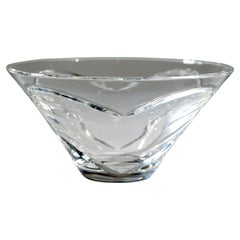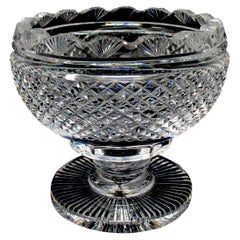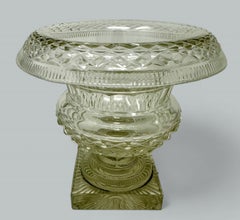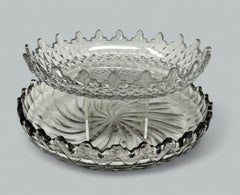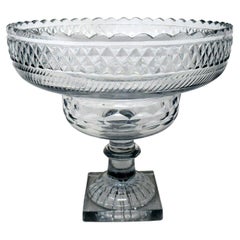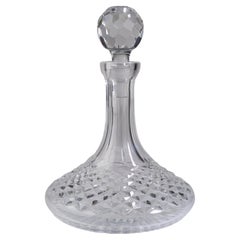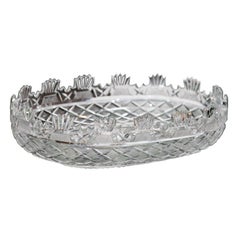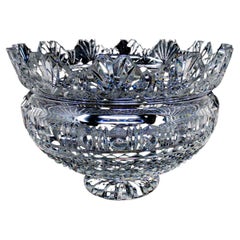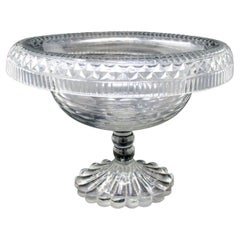Waterford Crystal Bowls and Baskets
Among glassware aficionados, the name Waterford has earned a place of eminence — both for antique crystal vases, glasses, chandeliers and serveware made by the original Irish company in the 18th and 19th centuries, and for new versions of the firm’s classic patterns produced after its rebirth in the 1940s. With either iteration, Waterford is a byword for traditional elegance.
Waterford crystal was born of a tax loophole. In 1783, business-minded brothers George and William Penrose founded the Waterford Glass House in southeastern Ireland because Irish glass was exempt from steep British import duties. The two wanted to make fine-quality wares and hired artisans from England, including master glassmaker John Hill. The factory’s flint glass — a precursor to lead crystal — soon won a clientele among British and continental aristocrats.
One of Hill’s aesthetic innovations was to polish glassware after a pattern was cut, to buff off the resulting frosted surface. The look became a Waterford trademark. Through the fame of its wine goblets, claret jugs and decanters, the firm continued to win honors at the many industrial expositions of the early Victorian era. But over those years, higher and higher luxury excise taxes were placed on fine crystal. Waterford products became prohibitively expensive, and the company closed in 1851.
The brand’s renown was still intact when it was revived in 1947 by a Czech glass manufacturer named Charles Bacik, who moved to Ireland after the Communist takeover of his country. For centuries, the region now called the Czech Republic had been the great glassware center of Middle Europe — the source of crystal to legendary Viennese glass design firms such as Lobmeyr and Bakalowits. So Bacik brought with him the master glassblower and designer Miroslav Havel.
In Dublin, Havel studied the old Waterford style book archives kept in the National Museum. He used these classic patterns as the basis for new ones such as Lismore, with its crosshatching and flame-like vertical cuts, and Alana, with its heavily textured diamond cuts. Past and present are thus linked at Waterford.
Introduced in 1991, the Marquis by Waterford range of vases, bowls and other wares were priced for everyday use and were intended for use in modern homes. It was the first new brand debuted by the company in what was then its more than two-century history.
As you will see on 1stDibs, antique or recently made, Waterford crystal is the essence of refinement.
Find Waterford crystal vases, serveware and other collectibles for sale on 1stDibs.
Early 2000s Irish Hollywood Regency Waterford Crystal Bowls and Baskets
Crystal
19th Century Irish Georgian Antique Waterford Crystal Bowls and Baskets
Crystal
19th Century Irish Victorian Antique Waterford Crystal Bowls and Baskets
Crystal
19th Century Irish Regency Antique Waterford Crystal Bowls and Baskets
Crystal
Late 20th Century Irish Modern Waterford Crystal Bowls and Baskets
Crystal
18th Century Irish Georgian Antique Waterford Crystal Bowls and Baskets
Crystal
21st Century and Contemporary Unknown Modern Waterford Crystal Bowls and Baskets
Glass
Mid-20th Century Irish Mid-Century Modern Waterford Crystal Bowls and Baskets
Crystal
19th Century Irish Victorian Antique Waterford Crystal Bowls and Baskets
Crystal
19th Century Irish Victorian Antique Waterford Crystal Bowls and Baskets
Crystal
Mid-20th Century Mid-Century Modern Waterford Crystal Bowls and Baskets
Glass
Late 20th Century Slovenian Waterford Crystal Bowls and Baskets
Crystal
Early 2000s Northern Irish Modern Waterford Crystal Bowls and Baskets
Crystal
Late 20th Century Irish Mid-Century Modern Waterford Crystal Bowls and Baskets
Crystal
1970s Vintage Waterford Crystal Bowls and Baskets
Crystal
19th Century French Classical Roman Antique Waterford Crystal Bowls and Baskets
Bronze
20th Century French Waterford Crystal Bowls and Baskets
Crystal
Early 20th Century American Art Nouveau Waterford Crystal Bowls and Baskets
Art Glass, Cut Glass
Late 20th Century Irish Victorian Waterford Crystal Bowls and Baskets
Crystal
19th Century Antique Waterford Crystal Bowls and Baskets
Opaline Glass
Late 20th Century British Waterford Crystal Bowls and Baskets
Crystal
20th Century French Modern Waterford Crystal Bowls and Baskets
Crystal
Late 20th Century Irish Waterford Crystal Bowls and Baskets
Crystal
20th Century Irish Mid-Century Modern Waterford Crystal Bowls and Baskets
Crystal
Early 20th Century French Art Deco Waterford Crystal Bowls and Baskets
Crystal
Mid-20th Century Irish Georgian Waterford Crystal Bowls and Baskets
Crystal
18th Century Irish Georgian Antique Waterford Crystal Bowls and Baskets
Crystal
18th Century Irish Georgian Antique Waterford Crystal Bowls and Baskets
Crystal, Sterling Silver
18th Century Irish Georgian Antique Waterford Crystal Bowls and Baskets
Crystal, Sterling Silver
18th Century Irish Georgian Antique Waterford Crystal Bowls and Baskets
Crystal, Sterling Silver
Mid-20th Century Irish Mid-Century Modern Waterford Crystal Bowls and Baskets
Crystal
19th Century Irish Georgian Antique Waterford Crystal Bowls and Baskets
Crystal
21st Century and Contemporary Irish Waterford Crystal Bowls and Baskets
Crystal
1970s Irish Victorian Vintage Waterford Crystal Bowls and Baskets
Crystal
19th Century Irish Georgian Antique Waterford Crystal Bowls and Baskets
Crystal
1980s Finnish Mid-Century Modern Vintage Waterford Crystal Bowls and Baskets
Art Glass
18th Century and Earlier Irish Georgian Antique Waterford Crystal Bowls and Baskets
Cut Glass
Waterford Crystal bowls and baskets for sale on 1stDibs.
- 1stDibs ExpertApril 16, 2024Yes, Waterford crystal typically has value. However, how much a particular piece is worth will depend on its type, style, age, condition, rarity and the current demand for similar items. A certified appraiser or experienced dealer can give you an estimate as to how much a particular Waterford piece is worth. Find a variety of Waterford crystal on 1stDibs.
- 1stDibs ExpertMarch 13, 2024To date Waterford crystal, look for the maker's mark. Since 1950, the brand has placed markings on discreet areas of its pieces. By comparing the mark on your crystal to images shared by trusted online sources, you can get a rough idea of how old your piece is. Alternatively, you can have a certified appraiser or experienced antiques dealer evaluate your piece. On 1stDibs, explore a wide range of Waterford crystal.
- How old is Waterford Crystal?1 Answer1stDibs ExpertMay 3, 2024Waterford Crystal is more than 225 years old. In 1783, business-minded brothers George and William Penrose founded the Waterford Glass House in southeastern Ireland because Irish glass was exempt from steep British import duties. The two wanted to make fine-quality wares and hired artisans from England, including master glassmaker John Hill. The factory's flint glass, a precursor to lead crystal, soon won a clientele among British and continental aristocrats. On 1stDibs, shop a wide range of Waterford Crystal pieces.
- 1stDibs ExpertSeptember 9, 2024Yes, some Waterford Crystal is worth something. Limited edition pieces produced by the Irish maker tend to be highly sought-after among collectors and may be valuable as a result. Typically, the age, type, style and condition of Waterford pieces influence their value. A certified appraiser or knowledgeable antiques dealer can evaluate your piece and provide a valuation. Explore a diverse assortment of Waterford Crystal on 1stDibs.
- 1stDibs ExpertFebruary 27, 2024Whether Waterford Marquis crystal is lead crystal depends on its age. Waterford gradually phased out the use of lead in its crystal wear and completely eliminated the material in 2023. Pieces manufactured before that time may or may not be lead crystal. On 1stDibs, shop a selection of Waterford crystal ware.
- 1stDibs ExpertApril 5, 2022To tell if something is Waterford crystal, grab a magnifying glass and look for the maker's mark. Prior to 2000, the company acid-stamped all of their pieces with the word "Waterford." Crystal made after that have an acid stamp shaped like a seahorse. Shop a range of expertly vetted Waterford crystal on 1stDibs.
- 1stDibs ExpertApril 5, 2022To check if your Waterford Crystal is vintage, you can check to see if the sticker or foil is still on the piece. There will be a green seahorse logo for Waterford. Also, check the stem to see if the logo has been etched into the crystal. Find a collection of expertly vetted Waterford Crystal pieces from some of the world’s top reputable sellers on 1stDibs.
- 1stDibs ExpertNovember 13, 2024To identify Waterford crystal marks, place your piece in an area that receives plenty of natural light and use a magnifying glass to examine it. Waterford first introduced markings in 1950. These initial marks display the brand name in Gothic lettering. A more contemporary script font replaced the original markings in 1986. Pieces produced in 2000 and beyond will feature a seahorse mark along with the brand name. Find a collection of Waterford crystal wares on 1stDibs.
- 1stDibs ExpertOctober 24, 2024To tell if a vase is Waterford crystal, search for the maker's markings. Nearly all Waterford crystal vases feature an acid stamp on their bottoms or interiors. Because this marking has changed over the years, you can compare it to references available on trusted websites to get a rough idea of the age of your piece. Some Waterford vases also feature foil labels. However, these may fall off or be removed by previous owners. If you're still unsure if your vase is a Waterford, a certified appraiser or knowledgeable antique dealer can provide an expert opinion. Explore a selection of Waterford crystal wares on 1stDibs.
- 1stDibs ExpertNovember 4, 2024To identify Waterford acid marks, hold your piece up to natural light and try using a magnifying glass. The maker began adding its name in Gothic characters to its crystal wares in 1950. In 1986, the acid marks changed to script lettering. Around 2000, Waterford incorporated its seahorse logo into the acid marks. Pieces produced before 1950 will normally not bear acid marks. On 1stDibs, shop a selection of Waterford crystal.
- 1stDibs ExpertApril 5, 2022Yes, some pieces of Waterford crystal are now crafted in The House of Waterford Crystal in Waterford, Ireland. Most Waterford factories, however, are located in Eastern Europe. Shop a range of authentic Waterford crystal from some of the world’s top sellers on 1stDibs.
- 1stDibs ExpertSeptember 16, 2024To find out how much your Waterford crystal is worth, one option is to conduct online research using trusted resources. By examining the previous selling prices for pieces similar to yours in terms of age, style, type and condition, you can get an idea of how much it may be worth. For a more precise valuation, consider seeking the opinion of a certified appraiser or knowledgeable antique dealer. Explore a range of Waterford crystal on 1stDibs.
